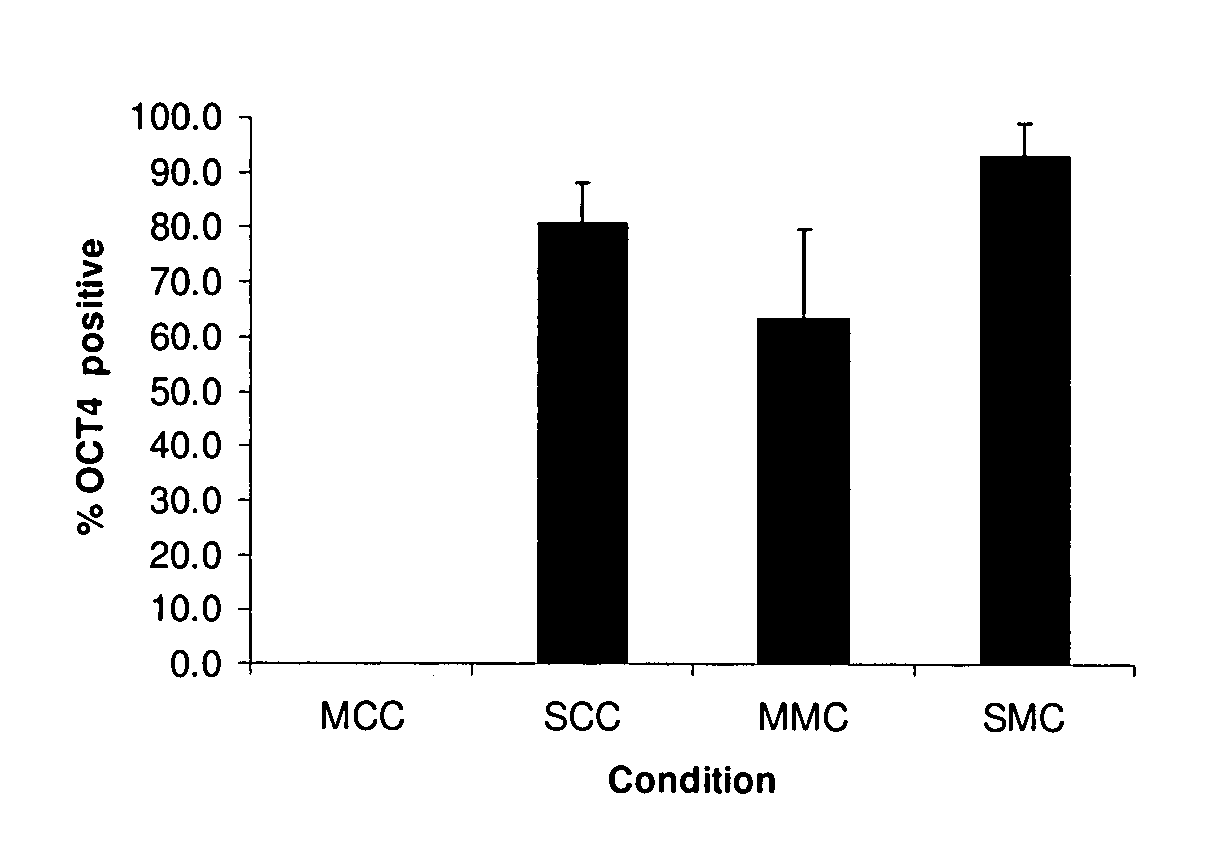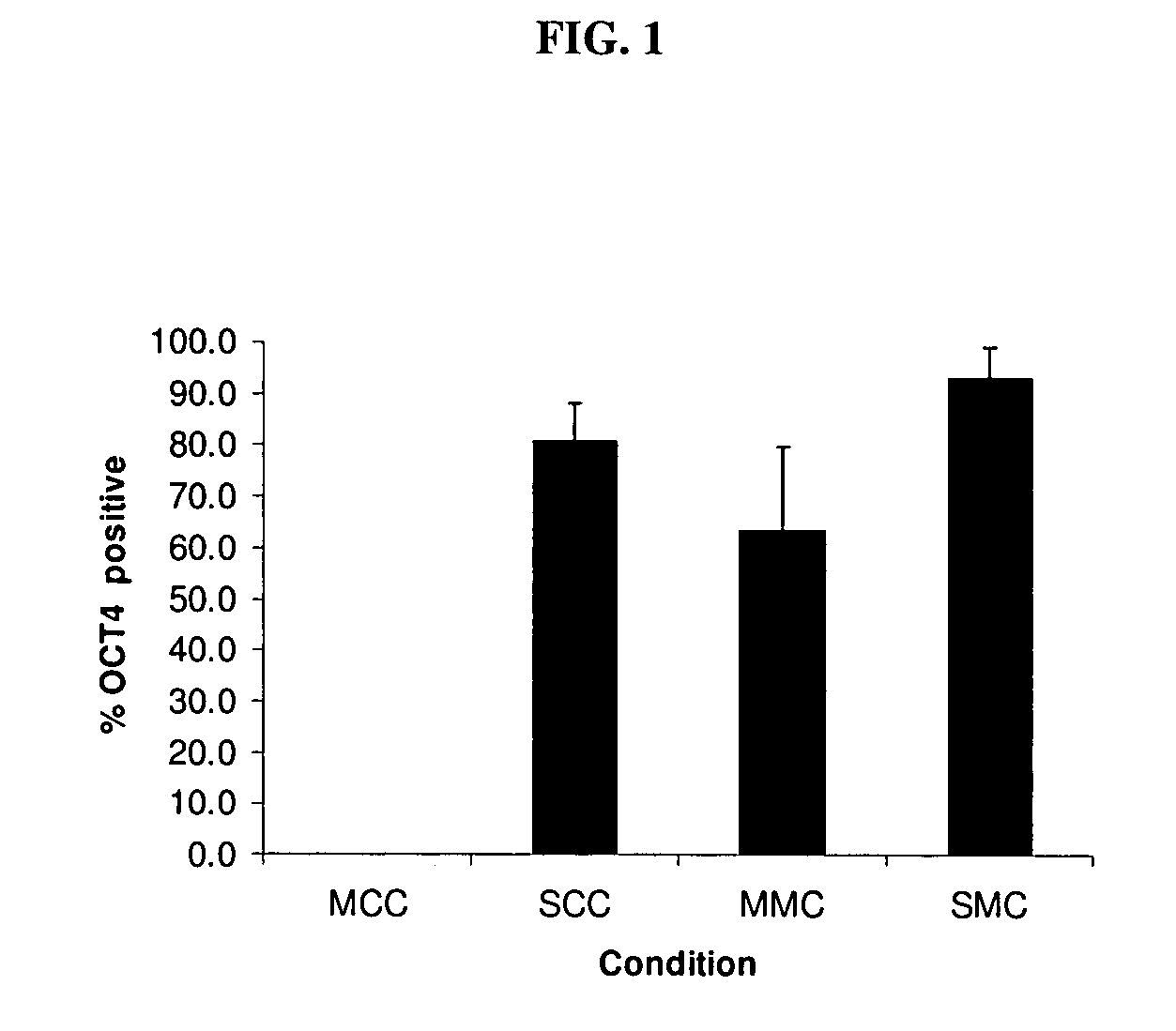Compostions and methods for growing human embryonic stem cells
a technology of stem cells and compostions, applied in the field of compostions and methods for growing human embryonic stem cells, can solve the problems of inability to find substitute cell types or to remove cells altogether, human or non-human use of es cells for human therapy, and the existence of potential contamination by infectious agents, so as to maintain the pluripotency of cells
- Summary
- Abstract
- Description
- Claims
- Application Information
AI Technical Summary
Benefits of technology
Problems solved by technology
Method used
Image
Examples
example 1
Derivation of Embryoid Germ Cell Derivatives
[0066]Human pluripotent germ cell cultures were derived from primordial germ cells, isolated and cultured as described above and in Shamblott et al., Proc. Natl. Acad. Sci. USA 95:13726-13731, 1998. Four genetically distinct human EG cell cultures were selected to represent the range of developmental stages at which human EG cultures can be initiated, with karyotypes as noted LV (46, XX), SL (46, XY), LU2 (46, XY) and SD (46, XX). These cultures were derived and cultured from 5, 6, 7, and 11 week post-fertilization primordial germ cells (PGCs), respectively. Embryoid bodies (EBs) were formed in the presence of leukemia inhibitory factor (LIF, 1000 U / ml), basic fibroblast growth factor (bFGF, 2 ng / ml), forskolin (10 μM) and 15% fetal calf serum (FCS, Hyclone). During routine growth, 1 to 5% of the multicellular EG colonies formed large fluid-filled cystic EBs that were loosely attached to a remaining EG colony or to the fibroblast feeder la...
example 2
Secreted Products Support ES Cell Growth
[0068]Many human cell types were screened for their ability to secrete products capable of supporting human ES cell proliferation, as judged by calculating population doubling rate, and percentage of cells expressing OCT4 after 3 passages in a particular environment. All initial studies used the MATRIGEL biomatrix. Almost none of the human cells provided an environment capable of supporting positive population doubling, and if a line was found to support a positive doubling rate, the rate was far below that provided by secreted products from mouse fibroblasts. Surprisingly, it was found that secreted products present in the culture medium of embryoid body-derived cell line LVEC (see Example 1) could support the growth of human ES cells. Culture medium was filter sterilized by passage through a 0.22 micrometer filter before testing, which removed any cells and provided a sterile product. Conditioned media containing secreted protein from LVEC c...
example 3
Secreted Products Support ES Cell Growth and Maintenance of Pluripotency
[0072]Additional studies using several ES cell lines were evaluated for the ability of cells to grow using secreted products described above. High levels of proliferation, and maintenance of pluripotency as determined by OCT4 expression, were demonstrated in WiCell line H1, WiCell line H9 (see http: / / www.wicell.org / ), and HUES 13 cells (see http: / / http: / / www.mcb.harvard.edu / melton / hues / ). Greater than 95% OCT4 positive cells were shown in 10-20 population doublings. Moreover, high levels of proliferation and maintenance of pluripotency were demonstrated using bovine or human type 1 collagen or superfibronectin as the substrate. Thus, such ES cells can be grown and maintained in an entirely human, cell free medium.
PUM
| Property | Measurement | Unit |
|---|---|---|
| humidity | aaaaa | aaaaa |
| humidity | aaaaa | aaaaa |
| humidity | aaaaa | aaaaa |
Abstract
Description
Claims
Application Information
 Login to View More
Login to View More - R&D
- Intellectual Property
- Life Sciences
- Materials
- Tech Scout
- Unparalleled Data Quality
- Higher Quality Content
- 60% Fewer Hallucinations
Browse by: Latest US Patents, China's latest patents, Technical Efficacy Thesaurus, Application Domain, Technology Topic, Popular Technical Reports.
© 2025 PatSnap. All rights reserved.Legal|Privacy policy|Modern Slavery Act Transparency Statement|Sitemap|About US| Contact US: help@patsnap.com


